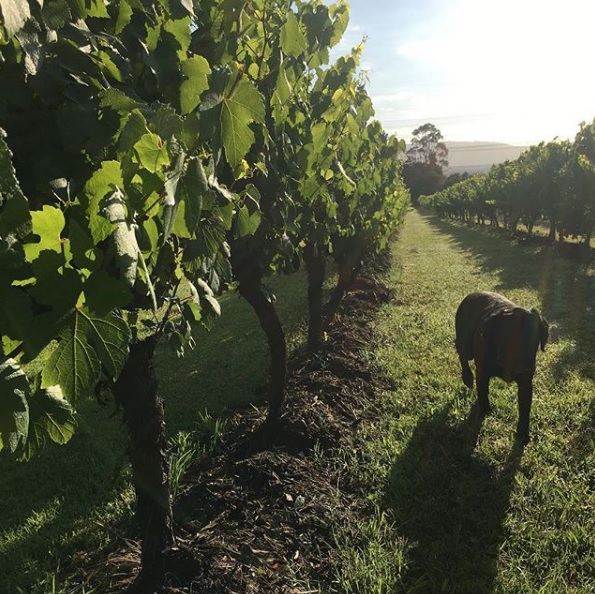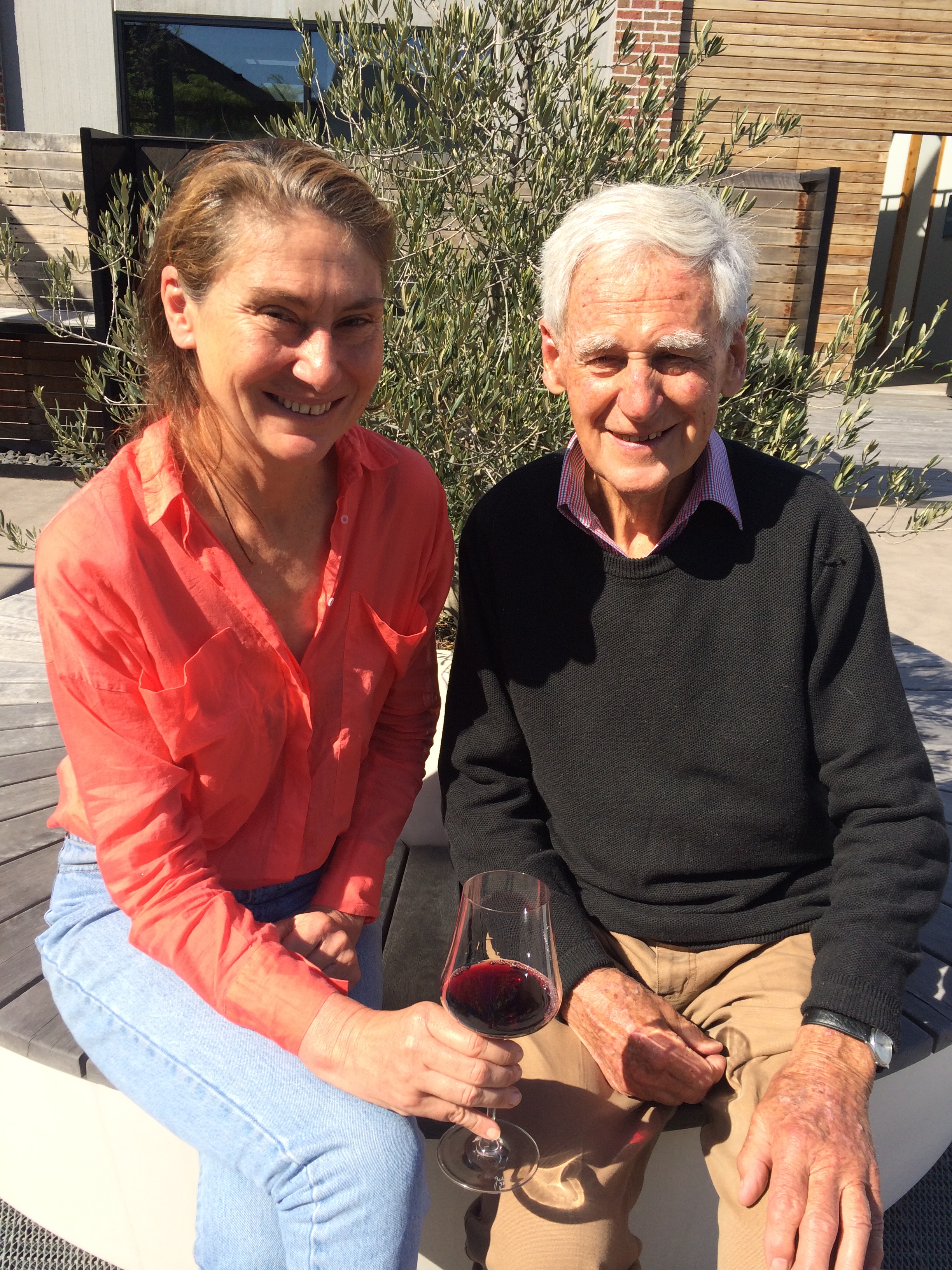 Wantirna Estate is a haven, an innocent bucolic fantasy seemingly oblivious to the din of modernity just beyond its borders. When Reg Egan planted it in 1963, he thought it inevitable that the vineyard would be swallowed by the suburbs, which back then petered out some way off. Thus it was conceived, to a degree, as an experiment – a chance to stick some vines in the ground to see what grew best on this cool-climate frontier. In went the likes of Riesling, Crouchen, Pedro Ximenez, Dolcetto, Grenache, Mataro and Shiraz. In the ‘70s the range was consolidated pretty much to the classics that grow there today.
Wantirna Estate is a haven, an innocent bucolic fantasy seemingly oblivious to the din of modernity just beyond its borders. When Reg Egan planted it in 1963, he thought it inevitable that the vineyard would be swallowed by the suburbs, which back then petered out some way off. Thus it was conceived, to a degree, as an experiment – a chance to stick some vines in the ground to see what grew best on this cool-climate frontier. In went the likes of Riesling, Crouchen, Pedro Ximenez, Dolcetto, Grenache, Mataro and Shiraz. In the ‘70s the range was consolidated pretty much to the classics that grow there today.
In the intervening years, suburbia has indeed mushroomed beyond this idyll. Thankfully, a surrounding swathe of Parks Victoria-owned land zoned as rural open space has provided protection for this special place.
The Egan family has honoured its slice of rural bliss. You sense it when you’re there; you taste it in the wines. Lately Maryann, Reg and the clan have focused on the regeneration of some of the 45- to 55-year-old vines, reworking rather than replacing so that they remain on their own roots. The old vines are therefore rooted, literally, in that humble past. At the same time they’ve evolved a long way from those origins as cuttings that share provenance with plants in other vineyards. With their unique character and exceptional quality, they bear the stamp and story of Wantirna Estate.
Mercifully this hasn’t turned out to be the fleeting experiment Reg had half anticipated. Instead it’s an enduring, engrossing tale. There is an air of ephemerality about each release, though, as the tiny production of this 10-acre plot vanishes in no time. Each year brings a chance to savour this charming family saga in tantalisingly small snippets. Don’t miss it!

THE WINES
“Wines of grace and quiet beauty from this producer. Invariably a treat.” – Gary Walsh, The Wine Front
2017 Wantirna Estate Isabella Chardonnay RRP $87
The 2017 season took us back in time. While budburst commenced around 10 days early, we hit a cool period in late October that delayed the shoot development. Flowering was then pushed back about two weeks later than the previous years. By the time we picked the Chardonnay on 6th March murmurs around the Valley were that it was a harvest ‘like back in the olden days’. February was pretty cool, with only three days in the mid-30s, and the nights were almost all below the average, often by more than 5–8°C. So cool was one stretch of evenings that long-term records were broken. These conditions were pretty perfect for the grapes to ripen slowly and without stress. Vintage 2017 was a lovely return to milder weather.
Our Chardonnay vines are nearly all on an east-facing slope, with the rows going in an east west orientation. On the flatter part of the slope the vines have produced poor yields for the past few years and it is this area that has been the continued focus of our compost work. The results have been really quite amazing – with the shoots going from being pencil thin in diameter to sturdy canes. This is certainly giving us some encouragement to continue with the tonnes and tonnes of hand spreading we’ve been doing each autumn. We’re seeing the leaves hanging on longer as well as a welcome increase in yield for the 2018 harvest. Just glancing at the extra piles of pruning wood that was removed this winter shows how much improvement we have been able to get into the soil. Unfortunately while conditions were perfect for ripening, the 2017 Isabella bunches were tiny, and therefore just five barrels of wine were made. But five barrels that we’re very happy with. – Maryann Egan
It’s not shy, but it is kind of discreet. Yellow fruit, butter menthol, aniseed and cedar spice. Medium-bodied, wheat germ and nectarine, a glossy feel but shot through with intense and fine acidity, the finish is long, with lemon curd and a tight tang of acidity. So lovely. 95 points. Gary Walsh, The Wine Front November 2018
2017 Wantirna Estate Lily Pinot Noir RRP $87
The February of 2017 was certainly welcomed by the Pinot grapes. Not only was it cooler than normal, but we even had some precious rain – 80mm, or about 50% more than average. The upshot of this was that the vines lost very few of their leaves, allowing the grapes to ripen nice and evenly without any dry heat spikes. So by the time some warm weather arrived in early March the majority of the maturity had been reached and although we then got some warm days, the grapes were in just perfect condition.
Of course there is always a ‘but’ to the story, and in this case it was the quantity. While the bunches were reasonably plentiful, they were tiny so our estimated yields proved to be optimistic. Suffice to say we didn’t have any overfull fermenters. The Front block of Pinot is about one acre with vines that were planted in 1985, so they’re reasonably old. The soil here is different to the rest of the vineyard, being quite a hard, dry grey soil. Usually we pick this block first, often over a week earlier, and in 2017 the fruit was harvested on 7th March, after a nice cool overnight temperature of 12°C.
The rest of the Pinot was harvested five days later, and unfortunately it was the same story: a lot less fruit than we’d hoped for. Both batches of grapes were hand harvested, de-stemmed and fermented in small open concrete or stainless steel fermenters. A portion was left to soak for a few extra days post fermentation and then, after pressing, the wines were matured in barrel until bottling in April 2018. Unfortunately the barrel count was just six; we are, however, thrilled with the resulting wine. – Maryann Egan
Raspberry, strawberry, vanilla, dried roses and general gorgeous fragrance. Ripe poached strawberry, light spice, fine dusty tannin, earthy and savoury, in among pretty red fruits. Orange peel twist on a nice long finish. It’s generous and warm-hearted this year, yet manages to keep itself lovely. 94 points. Gary Walsh, The Wine Front November 2018
2016 Wantirna Estate Amelia Cabernet Sauvignon / Merlot RRP $87
Harvest Merlot in February? Unheard of! Well it was on the 29th day but still… Ridiculous! But with a very early budburst and flowering back in October 2015, the harvest of 2016 was an early one. Thankfully it was a cool February. Like the 2015 Amelia, the proportion of the main varieties is quite even – around 45% Cabernet Sauvignon, 45% Merlot/Cabernet Franc and about 10% Petit Verdot. The balance slightly changes every year given that we grow all our grapes here, so in a true single-vineyard style we can only use what this tiny plot of 10 acres grows. And like the 2015 we have continued to make the wine in a few small open fermenters, rather than one big one (not that we ever had really large ones!). The hand-plunging with the occasional pumpover gives us good fruit development; we had steady, even ferments and the small vats allow us to hold a batch or two back to give extended skin maceration.
Typically the wine sees about 25 to 30% new wood. For the Cabernet Merlot wines we particularly like the cooper Dargaud & Jaegle and their barrels that are made in a small town between Lyon and Mâcon. The oak comes from the forests in central France and we like the restrained influence it has. Oak we believe should just be a nice complexing flavour, a flavour that sits in the background of the wine, rather than being a main feature.
The 2016 Amelia follows on in style and quality of the 2015. And like many a Yarra Cabernet blend, it is delicious as a young wine yet develops beautifully in bottle. – Maryann Egan
Violet and cigar box perfume, red and black fruits, pencils and vanilla. Medium-bodied, fleshy but gentle tannin, deep flavour delivered with a light touch, fine long finish, poise and elegant feel from start to finish. Classic. Beautiful Cabernet. 95 points. – Gary Walsh, The Wine Front October 2018
2016 Wantirna Estate Hannah Cabernet Franc / Merlot RRP $156
Those who have been buying our wine for a while will remember the impetus for the making of the Hannah – there was simply the need to make a fourth wine to name after the fourth granddaughter! It so happened that among the family there was a love of the wines of St Emilion, where the overwhelming majority of estates make their wines from varying proportions of Merlot and Cabernet Franc (some have a little bit of Cabernet Sauvignon too). So of course the occasional trip needs to be taken to the region of Bordeaux and to spend a few days tasting the wines of the area.
It had been a few years since I’d been to Saint Emilion, and despite its popularity these days, it is still a slice of heaven. And the Bordelais certainly know how to impress with their gorgeous châteaux. The wines too were pretty fabulous, albeit at an eye-watering cost. Interestingly many have moved to bottle these Cabernet Franc and Merlot wines a little earlier than the Cabernet Sauvignon-dominant wines. We adopted this practice 10 years ago with the 2008 Hannah. Certainly the odd museum tasting that we do of the Hannah shows the wine develops beautifully while maintaining the lovely fruit flavours and fragrance that Cabernet Franc in particular gives.
Also interesting from the trip, which also included Piedmont and Burgundy, was the intense interest from other winemakers in our experience with using screwcaps. We got the impression that many would love to be adopting these as their closure but don’t have the confidence or appellation regulations to just do it! Certainly we are more than happy with screwcap, especially when the dreaded ‘It’s corked!’ words are heard. As usual, just the one barrel made.- Maryann Egan